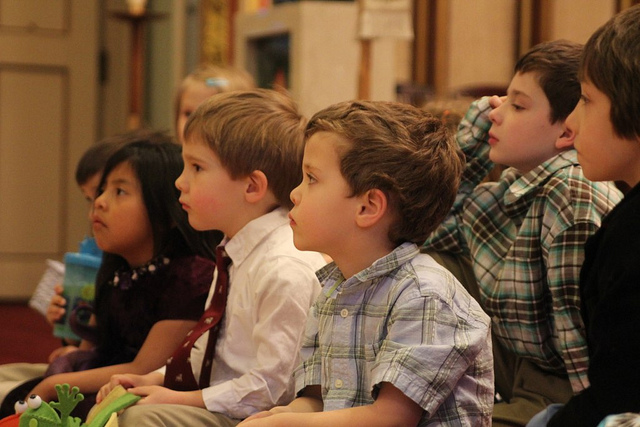Working Preachers, does this sound familiar: you’re wheeling your cart through the grocery store when you see the nice young couple from church who sit with pained expressions as they try to keep their young kids behaving — their daughter SCREAMED through the sermon and they haven’t been back since. Your carts approach, they smile guiltily and say, “Hi, Pastor; I know we haven’t been to church lately — with trying to wrangle these two, we just don’t get anything out of the sermon…”
Recently, I had the chance to be one of those parents in the pew with my 3 ½ year-old and my 22-month-old. It was one of my rare Sunday vacations, and sure enough, during the sermon I alternated between finding more Cheerios, picking up the lost toy, sliding my 22-month-old OUT from under the pew, and, rarely, actually listening.
And truth be told: I didn’t get very much out of it.
Now, before we get sidetracked, let me state it clearly that I don’t truly “buy” that as an excuse for young families not to come to church. I’ve witnessed powerful acts of a village raising a child when a church rallies around a young family whose children are learning how to be in church. And ultimately, it’s not about what the parents get out of the service: it’s about God. I’m on board.
But after my recent experience of actually being one of those parents in the pew, I started to wonder: are there perhaps some practical tools that preachers could implement which could help those young parents “get more” out of the sermon? Could those same practical tools assist the whole congregation in staying engaged with the sermon when a 2-year-old is having a “Terrible Twos” moments? Is it possible those rhetorical tools could actually make the sermon more accessible even to the youngest members of the church while still allowing the content to be at a high theological level?
After some thinking, experimenting, and some good ol’ millennial digital crowd-sourcing, I’ve come up with a few suggestions on preaching so that Mikey, his parents, and the whole congregation might actually be able to hear you:
- When a child screams, don’t go louder — go slower.
- I used to say to young parents, “Don’t worry if ___ starts screaming; I’ll just talk louder!” But then sermons became a shouting match between the preacher and the 9-month-old, and everyone was uncomfortable. Instead I’ve found that slowing down, even repeating the same sentence or phrase a few times until the spasm passes, to be more effective. Kids’ loud noises don’t usually last that long; if you can stay at the same spot in your sermon, it will allow the parents — and the congregation — to not have missed much when they’re able to check back in. (This is also helpful with adults of differing needs who may have vocal outbursts and need a minute to calm down.)
- Have a theme phrase, and repeat the heck out of it
- When I was in the pew with my squirmers, I remember wishing that the preacher had a phrase or sentence that was repeated throughout the sermon. That way, parents (and kids!) could know up front the theme of the sermon, and they could reorient themselves quickly to where you are in the sermon if they have to drop in and out of attention to tend to the needs of their children. Shout out to Pastor Tim Wrenn whose young parents enjoy the 20-second “sermon in a nutshell” at the very end, a helpful summary for those who had to check in and out a bit.
- Make it worth their while (the kids, I mean)
- Help those parents out! If you can find a small hook to offer the kids throughout the arc of the worship service, it gives them that much more incentive to actually be listening — and maybe that’s one or two less times the parents have to check out. Said Susan Lee, “If there was just one hook to catch my sons’ interest even for only a couple of minutes, then I am able to focus on the sermon as well.” There are lots of ideas on the internet for different ways to do this: a fantastic suggestion from Sarah Trone Garriott was to ask the kids to do or say something whenever she gives them a signal. For example, she writes, “During Advent 1b I passed out party horns during the children’s sermon with strict instructions not to blow them unless I said ‘keep awake.’ They blew them during the gospel, sermon, and worship just as instructed.” Bonus idea: if you give them to the parents too, it can be something silly and fun they do together — and you’ve just facilitated a shared faith experience.
- Ask questions
- This of course depends on the space and size of the congregation to which you are preaching. But just a quick anecdote: when I was on internship, I experimented with asking questions and receiving answers during my sermons to a worshipping group of about 100 people. On one of my last Sundays, I asked a question, there was a thoughtful pause, and then from one of the front pews, a quiet little 5-year-old spoke up with a perfect response. It was completely unexpected, but just goes to show how much kids actually are listening.
- Make it visual if at all possible
- If you have PowerPoint capabilities, take advantage of the human brain’s ability to rapidly process visual images. If I’m in the midst of shushing my 2-year-old and can glance up and see a picture and a phrase that goes with it, it will help me keep on track with where you’re going in your sermon even though my child needs most of my attention at the moment. Don’t have PowerPoint? Bring an object to hold and reference — or pass around — while you preach.
- Encourage those parents to get ‘em in the front
- Ok, ok, yes, I confess: on that recent Sunday that I keep mentioning, I definitely sat in the back. But imagine yourself to as a <3-ft.-tall-year-old, and what can you see from the back of the church? At best, the top of the pew in front of you; at worst, just a whole lotta butts. Kids pay better attention when they’re actually in a spot where something can capture their attention. This of course is true for all people — but yah, I know, good luck getting Great-Uncle Marvin to budge.
One of our goals is to make our sermons, as Leon Morris said of the book of John, “shallow enough for a child to wade and deep enough for an elephant to swim.” As Working Preachers, we’re usually pretty good at making room for elephants; here are just a couple of tips to offer our youngest Christians — and their parents — a bit of a Puddle Jumper along the way.

